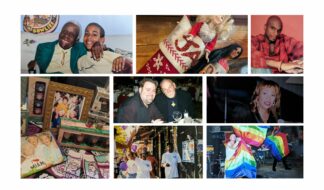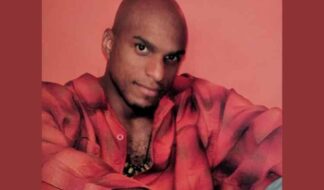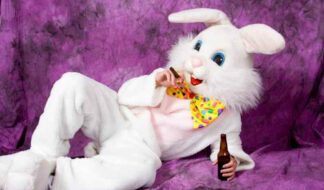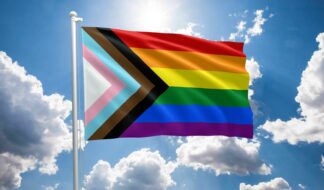BY DANA RUDOLPH

Halloween is almost here, which for many of us means trips to the store to purchase overpriced costumes or hours spent sewing and hot-glueing homemade versions, both for our kids and for ourselves. October is also, however, LGBTQ History Month and the month of National Coming Out Day, making Halloween's topics of heroes and hidden identities relevant in multiple ways. Here are some things that Halloween offers to support and sustain our multifaceted queer selves.
The chance to explore our gender identities and expression: For some queer people, Halloween offers yet another occasion to don drag costumes, often with more public acceptance than at other times of year. For others, it gives us the chance to explore different ways of expressing gender–say, as a pirate princess, butch fairy, or pink-clad construction worker.
Don't confuse any of that with being transgender, however. For trans people, I refer you to Meredith Talusan's October 2015 BuzzFeed piece, "Why Trans Women Have Complicated Relationships With Halloween," where she offers perspectives from a number of trans women and observes, "Halloween is the one day of the year when those assigned male are allowed to dress as women in public…. It has a significant place in the lives of many trans women and non-binary femmes." At the same time, her article reminds us that Halloween may reinforce the misconception that being transgender is the same as simply putting on a costume.
We can apply these learnings with young people as well. In recent years, I have seen numerous stories of children assigned male at birth who want to be princesses for Halloween. For some, this may simply be a matter of being temporarily attracted to a particular costume. It may allow children to explore and stretch the bounds of their gender expression. For others, though, it may be a first step towards manifesting their true gender identities. The same goes for children assigned female at birth who want
to dress up as male heroes. Kudos to the parents, teachers, and friends in all cases who let the children be themselves.
The chance to honor our heroes, real or imagined: I predict many children and adults will be Wonder Women this year, after the movie gave us a rare instance of a female superhero lead character (who in the paper comics is canonically bisexual). For real-life queer icons, check lgbthistorymonth.com for ideas. Remember, however, that we shouldn't change our skin color with makeup or wear clothing or symbols of another culture, as that can reinforce racist stereotypes or disrespect sacred symbols.
Similarly, it bears repeating that dressing up as a trans person if you're not trans can convey the damaging idea that being trans equals wearing a costume. Even if you mean the costume respectfully, it may not be seen as such. There are plenty of other options out there. If all else fails, find some friends and go as the colors of a Pride flag. Or cut two holes in a sheet and go as the Ghost of Pride Month Past.
What would you say to your Scrooge? The chance to confront our fears: Whether it's taking our kiddies to a "haunted" corn maze or watching a scary movie, it can sometimes feel therapeutic to confront and overcome our fears, especially in an era when intolerance, inequity, violence, and natural disasters are all too real. We can practice on a small scale how to brace ourselves, support others, and find the support we need. Will this make real fears less scary? No, but it may help us better cope with them.
The chance to talk about gender, culture, race, and religion: Many commercial Halloween costumes aimed at women and even young girls are oversexualized or gendered to exaggeration with short skirts and glitter, including ones like "police officer" and "firefighter." If we encounter them at the store with our children, we can explain that they are based on old-fashioned views that said women couldn't "really" do these jobs and thus didn't need practical clothing for them. With older children, we can introduce and explain the dangerous idea of women as sex objects. We can also discuss why it is inappropriate to dress up as someone of another race or culture. See Teaching Tolerance's article "What Do Halloween Costumes Say?" for ways of approaching these topics with children. (Visit tolerance.org and search for the title.)
Additionally, we can introduce the concept that more observant families of some religions may not even celebrate Halloween, which started as a Christian observance. Take the opportunity to learn and teach your children about Sukkot, the Jewish harvest festival, or Diwali, the Hindu festival of lights, which also occur around the same time.
The chance to eat treats–but also to be thoughtful about what we eat and serve to others: Halloween, of course, tends to be a candy gorge-fest. Be aware, though, of those who for reasons of allergies, diabetes, gluten intolerance, or other medical conditions can't indulge the same way as others. Many supermarkets now stock diabetes-friendly, gluten-free, and peanut-free treats, so it's easy to offer those, too.
Taking care with candy and costumes might seem to be dampening the fun of Halloween, but really, these are small efforts that can make the holiday more fun for everyone. After all, if Halloween is a very queer holiday, what's more queer than supporting the ideas of inclusion and community? It's the opposite that is truly scary.










